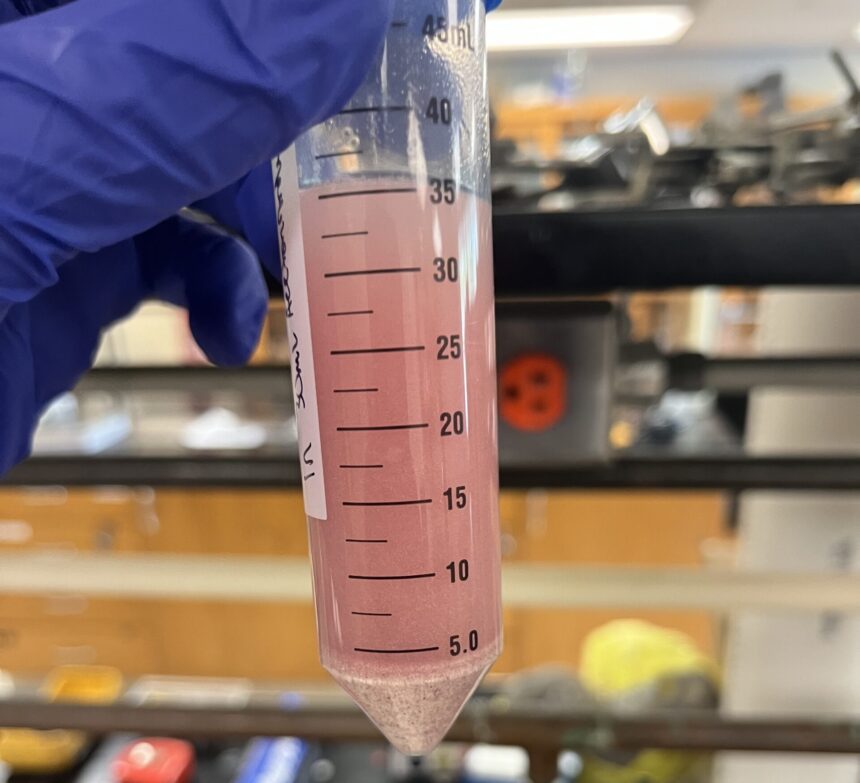Spoelstra used various techniques to check the accuracy of CBD label claims. Courtesy | Joey Spoelstra
Senior biochemistry student Joey Spoelstra tested various CBD products and found that label claims were often inaccurate.
Spoelstra presented his findings to the Association of Analytical Chemists in Livonia Michigan, on Nov. 9.
“The main point of the research was to compare the label claims on the actual products to what was actually in them through analysis,” Spoelstra said. “I found that they were generally inaccurate for most of the products I tested.”
Spoelstra used various methods to test the CBD products under the supervision of his research mentor, professor of chemistry Mark Nussbaum.
Nussbaum said that Spoelstra first heated the CBD products using a gas chromatography instrument. The CBD instantly degraded to form THC. CBD and THC are both chemical compounds found in the marijuana plant — but THC has psychoactive effects, while CBD does not.
“Degradation is when one compound becomes another due to outside factors like temperature and light,” Spoelstra said. “In this case, I put the samples under conditions like increased temperature and light and measured how much the CBD degraded into THC. The heat degrades CBD into THC, and THC has negative health effects in humans.”
After gas chromatography, Spoelstra experimented with liquid chromatography, according to Nussbaum.
“Liquid chromatography is a technique that doesn’t require that you heat the sample up in order to get into the instrument,” Nussbaum said. “He developed a good method for separating several different marijuana compounds that are related to CBD.”
Spoelstra also placed the CBD products in simulated gastric fluid to see how they would likely break down in the human stomach. He said the gastric acid did not dissolve CBD as well as the label claimed it should have.
Spoelstra said he baked the CBD products into brownies to find out what happens when CBD is mixed with chocolate.
“One of them got baked at super high temperatures and it ruined the entire sample so I couldn’t use it,” Spoelstra said. “It went up in 10 seconds and completely ruined the beaker.”
Nussbaum said that Spoelstra became increasingly independent in his use of the instruments as time went on.
Spoelstra said he piggybacked off CBD research that Marie Taylor ’23, had conducted.
According to senior chemistry student Dana Gramckow, who worked on a separate project, they spent six weeks working on their projects for five days a week.
“We were there from 8:30 until 5:00 every day,” Gramckow said.
CBD should be illegal until the FDA can determine better procedures to ensure safety, according to Spoelstra.
“These different companies are making CBD, and they are not accurate by any means,” Spoelstra said. “And the biggest reason for that, in my opinion, is the fact that the FDA isn’t properly regulating that or controlling it so that it’s safe for the public.”
He said an issue with states legalizing marijuana is that the FDA’s quality control is flawed in the way it determines the amount of both THC and CBD in CBD products.
Nussbaum said that when it comes to FDA regulations, hemp-related compounds slip through the cracks because they are not considered either pharmaceutical compounds or food supplements.
“They’ve been lumped with agricultural products,” Nussbaum said. “And that’s been a big loophole for companies to be able to sell CBD without having to have all the testing and various proof of purity and things that they would normally have if it was being sold as a drug or food supplement.”
Nussbaum said that there has been a lot of false advertising about CBD’s capabilities.
“There needs to be more oversight on those who manufacture CBD oils so that they are correctly producing pure components,” Nussbaum said.
![]()

